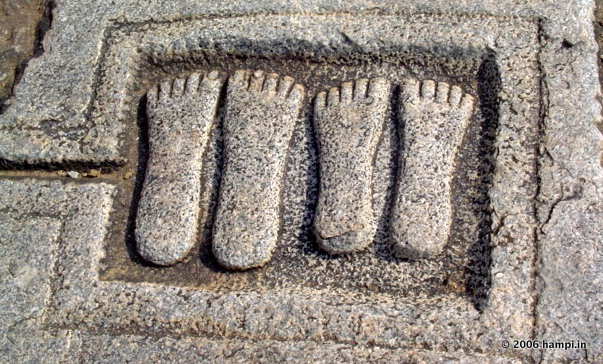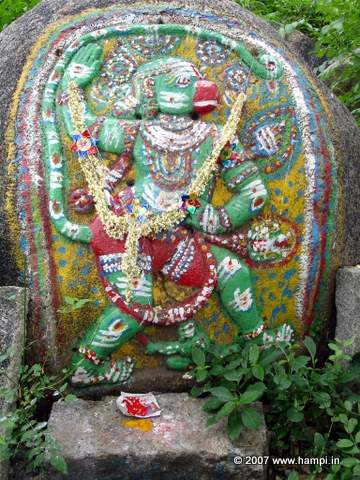Religions of Hampi

Footprint carving in Hampi
Footprint carving in Hampi
T
he far end of religious history of Hampi somehow morphs into mythology. The significant events narrated in the Hindu epic Ramayana (believed to have originally composed in 1st century BC) is believed to have happened in the settings surrounding Hampi. The most imperative is the section narrating the monkey kingdom - Kishkindha.Hinduism in Hampi had two major sects. The Saivites and the Vaishnavites. The former worships the destroyer/reformer God Siva whereas the later worships Lord Vishnu (the preserver or maintainer). Both of these cults of Hinduism had been (and still is) in practice in Hampi. And then there are a number of sub-cults of branched out of these faiths. Out of these two, the Shiva worship had been the oldest in Hampi. The epicenter of this cult was the Virupaksha temple. Even today it is one of the important pilgrimage centre for Siva worshipers.
The kings of the initial days of Vijayanagara adopted Virupaksha (Siva) as the sentinel deity of the kingdom. During these periods the Virupaksha Temple too had undergone a systematic upgrade in its architecture. It’s believed that the original Virupaksha temple had been a very ordinary shrine on the bank of the river Tungabhadra. Later kings added the imposing towers & other structures to the temple.
The Vaishnava cults grew strength probably during the peak days of the Vijayanagara Empire. Except the Virupaksha temple, all other grandstanding temples of Hampi were dedicated to the lord Vishnu and his various incarnations. The Vittala temple, Krishna Temple, Tiruvengalanatha temple, Hazara Rama Temple, Pattabhirama Temple, are all proof of this. Somehow the later kings of the Vaishnava faith built these temples with enthusiasm. The grand architectural plans and the fine details of these temples speak of their religious passion.
In the later days of the Vijayanagara empire, the religious center of gravity has shifted from around the Virupaksha temple in the west to the Vittala temple in the east of Hampi.
If you draw a vertical line on the Hampi’s landscape keeping the Matanga Hill at the center, the eastern areas are sprinkled with the temples and shrines of Vishnu faith and the west of Shiva faith. There are some major exceptions though. The largest Siva idol (linga) is located south of the Krishna Temple. Interestingly the largest Vishnu icon, the icon of Lakshmi Narasimha, is located just next to this linga.
Apart from these mainstream sects, there are a number of noteworthy beliefs practiced in Hampi. The numerous shrines and motifs of Hanuman (the monkey God) across the length and breadth of Hampi illustrate the significance associated to this faith. Hanuman is associated with strength and loyalty. Generally all the gateways in this medieval city had a Hanuman shrine next to it. When you explore Hampi you would realize this thanks to the number of Hanuman motifs scattered all around. The biggest of the Hanuman motif is located inside the Ranga Temple near the Elephant Stables.
The far and few but the presence of Virabhadra temples suggests of this cult’s (the people who worship Shiva in one of his furious incarnations) presence. So was the worship of the Kali (another fearsome Goddess associated with Shiva). All of these practices are intact even today, as it was many centuries back. The most important, and possibly with the largest, idol of Veerabhadra is in the Uddana Veerabhadra Temple.
The presence of Islamic faith in the Hampi’s social moorings is interesting. As an imperial capital, Hampi had a cosmopolitan outlook. Though it is the Sultans of the Deccan brought down the empire, Hampi had a sizeable Muslim population. So was in its army’s composition. It’s peculiar to see the religious carvings on the Temple structures with Muslim characteristics. For example, the carvings where Muslim soldiers riding the mythical Yali of Hindu mythology. The kitchen or the storehouse of Krishna Temple made in the typical Islamic style architecture.
A number of buildings in Hampi have been identified to be associated with Islamic faith. There are a number of Mosques and Dargahs (shrines of revered religious figures) dotted especially at the southwest diagonal area of the capital. The present day Kadirampura is believed to be the residential quarters of the Muslim army officers.
An area lying between the Kamalapura and Vittala Temple was known as the Islamic quarter. A mosque is located at the centre of this area known after Ahmed Khan, a high officer in the court of Krishnadevaraya II. The architecture of is a pleasant deviation from the typical Islamic style. For a moment this could be mistaken for a Hindu style ceremonial hall.
It is believed that king Krishnadevaraya kept a copy of the holy Quran on a pedestal next to his throne. He probably used it as a pledge of his patron to the religion and also used it to take oath when Muslim officers are appointed.
The Jain temple of the eastern area with its inscriptions speaks of the patronage this faith enjoyed. History also speaks of the animosity between the Hindu & Jain faiths and how some of the kings tried to mend the hostility.
All in all Hampi had been a religious place throughout, where pilgrims from far away places flocked. It continues to be so. The rulers of Hampi might have gone with the torrent of time. Hampi’s faiths remain, intact and deep-rooted.

Hanuman image
Hanuman image located near the Talarighata ferry point
